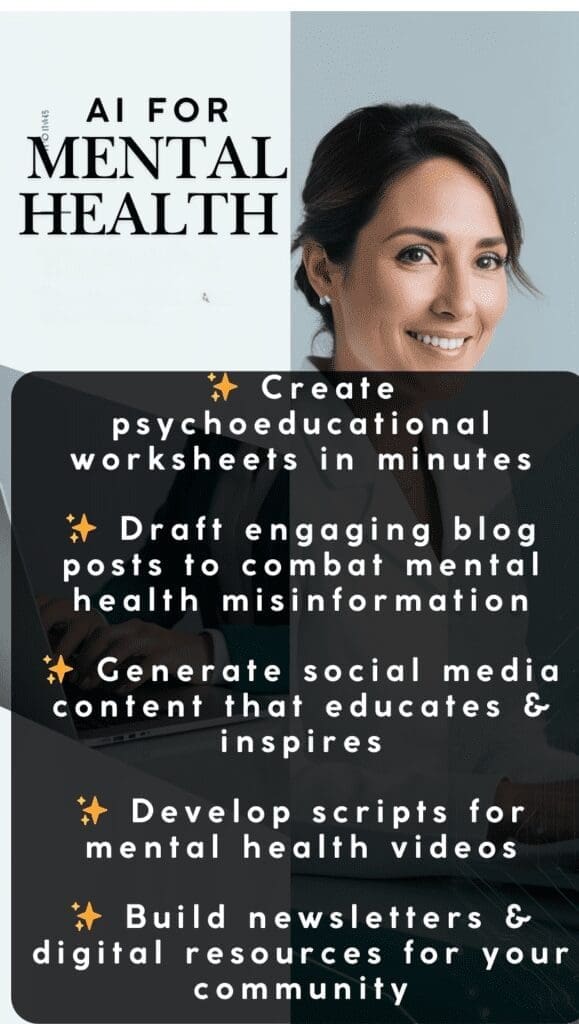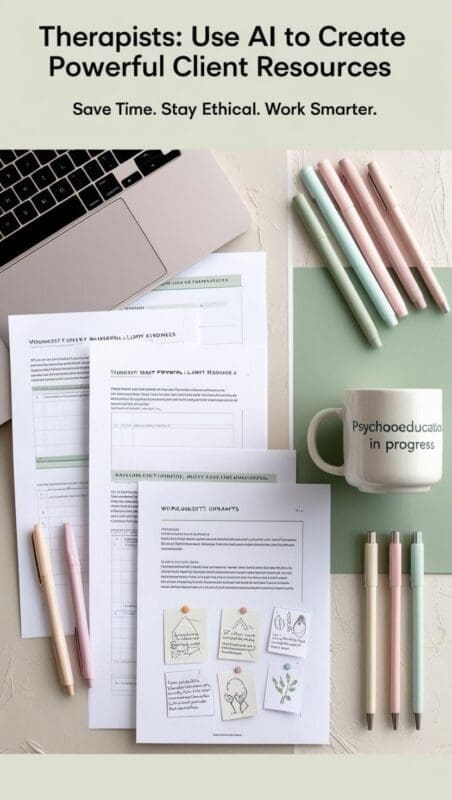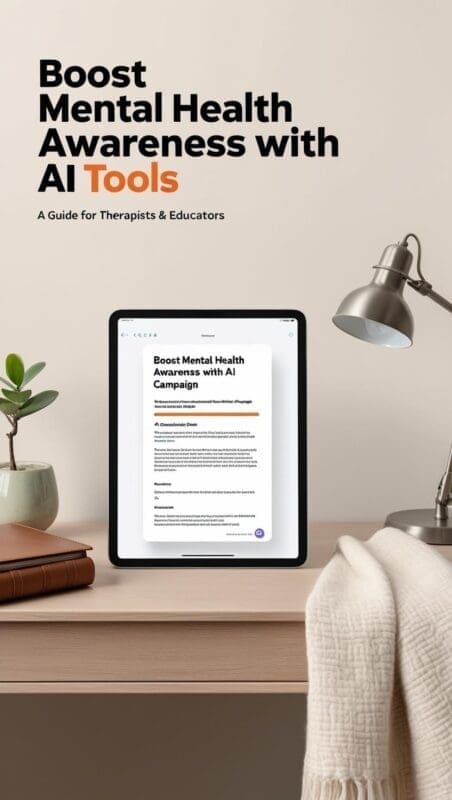As therapists, one of our most powerful tools isn’t just what we say in the room—it’s what we teach. Psychoeducation helps clients understand their symptoms, normalize their experiences, and build the skills they need for real, lasting change. But creating high-quality educational content—like handouts, blog posts, or social media visuals—takes time many of us simply don’t have.
That’s where AI, including tools like ChatGPT, can become a helpful ally.
Used thoughtfully, AI can help therapists generate accurate, accessible psychoeducational materials that align with their clinical goals. From simplifying complex mental health topics to brainstorming ways to raise awareness during Mental Health Month, AI can streamline the creative process without replacing your professional expertise or ethical responsibility.
In this article, I’ll walk you through how therapists can use AI tools like ChatGPT to support psychoeducation, improve client engagement, and advocate for mental health awareness in a way that’s practical, ethical, and time-saving.

How Therapists Can Use AI for Psychoeducation & Mental Health Awareness
In a world where information is everywhere—but not always accurate—therapists are stepping up to educate, clarify, and support mental health literacy. Whether you’re running a private practice, managing a wellness blog, or creating content for social media, one thing is clear: psychoeducation matters. But let’s be honest—it’s also time-consuming.
This is where AI tools like ChatGPT can offer real support.
When used ethically and intentionally, AI can help therapists save hours on writing, brainstorming, and organizing content without compromising quality or professionalism. In this article, I’ll walk you through realistic ways to use AI to support your psychoeducational work—while always keeping your clinical judgment front and center.
1. Drafting Psychoeducational Worksheets
Designing meaningful worksheets is part of many therapists’ workflow, but starting from scratch each time isn’t sustainable. AI can assist by generating quick drafts for common topics like coping skills, thought-challenging exercises, or self-reflection prompts.
How AI Helps:
- Generates first drafts based on your prompt
- Saves time on formatting and layout brainstorming
- Provides neutral language that can be customized for your tone or population
Example: Working with panic-prone clients? Ask ChatGPT to draft a grounding techniques worksheet. You’ll get a usable framework that you can then refine by adding therapeutic prompts, visuals, or branding.
Pro Tip: Practice a few times with different prompts—AI improves as you get more specific.
2. Blogging for Mental Health Awareness
Therapist-written blogs are powerful tools for combatting misinformation and sharing client-friendly insights. But sitting down to write a full post can be overwhelming when you’re juggling a caseload.
How AI Helps:
- Helps outline your blog structure in minutes
- Suggests titles, section headers, or FAQs to include
- Offers starting language you can rewrite using your clinical voice
Example: Specialize in CBT? Ask ChatGPT to create a beginner-friendly guide to cognitive distortions. It can list common patterns like catastrophizing or overgeneralizing, and you can add relatable stories or client insights.
Why It Works: Blogging builds trust, supports SEO, and reinforces your professional authority online.
3. Creating Engaging Social Media Content
Social media has become a go-to source for mental health education. The challenge? Creating posts that are both helpful and digestible.
How AI Helps:
- Suggests caption ideas, carousel content, or hashtags
- Breaks down complex topics into bite-sized tips
- Offers daily or weekly post planners to keep you consistent
Example: Want to do a self-care series for fellow therapists? Ask AI to generate a 7-day self-care challenge. Then customize it with your voice, photos, and practice niche.
Bonus: It’s a great way to boost engagement while building community around shared experiences.
4. Scripting Short Educational Videos
Video content is booming—especially for therapists reaching wider audiences through YouTube, Reels, or TikTok.
How AI Helps:
- Generates talking points or outlines for 1–5 minute videos
- Suggests keywords or descriptions for YouTube optimization
- Helps you find simple metaphors or analogies to explain difficult concepts
Example: Create a video on the mental health benefits of better sleep. ChatGPT can list 3–5 quick facts plus a closing call to action. You add your personal insights and delivery style.
Why It Works: Video builds trust fast—and boosts visibility on platforms where your future clients may already be scrolling.
5. Writing Newsletters & Email Series
Newsletters are an underrated way to build deeper relationships with your audience and share psychoeducation directly in their inbox.
How AI Helps:
- Suggests monthly topics based on seasonal or trending mental health themes
- Helps with subject line ideas and opening hooks
- Can draft sections like book reviews, coping tips, or self-reflection questions
Example: Writing an October email? Ask AI for newsletter content focused on Seasonal Affective Disorder. It might suggest a light therapy review, journaling prompts, and tips for adjusting routines as daylight shifts.
Time Saver: You can create a whole content calendar in a single brainstorming session with AI.

6. Designing Workshop Materials
Workshops require structure—lesson plans, prompts, summaries, and handouts. AI can help you plan these components quickly and clearly.
How AI Helps:
- Creates outlines or agendas for live or virtual events
- Drafts discussion prompts or case examples for group work
- Helps design reflection exercises and takeaway summaries
Example: Hosting a workshop on emotional intelligence? Ask ChatGPT to generate group prompts or role-play scenarios. You’ll still tailor them to your audience, but the foundation is ready to go.
Why It Works: It reduces prep time so you can focus on the human side of facilitation.
7. Drafting Guided Meditations or Relaxation Scripts
If you use mindfulness or grounding in your practice, you know that guided scripts can be a powerful tool—but also time-consuming to write from scratch.
How AI Helps:
- Generates first drafts based on tone (calm, uplifting, grounding)
- Tailors scripts for length, age group, or theme (sleep, anxiety, body scan, etc.)
Example: Running a stress-relief group? Ask ChatGPT to write a 5-minute body scan. You can then tweak pacing, language, and imagery to match your facilitation style.
8. Creating Downloadable Resources or E-Books
Digital products like e-books or printable guides are great for building passive income, growing your email list, or reaching people outside your 1:1 sessions.
How AI Helps:
- Suggests structure for your guide or workbook
- Generates sample chapters or summaries
- Helps create checklists, reflection sections, and topic breakdowns
Example: Writing an e-book on navigating grief? AI can help organize chapters (e.g., stages of grief, coping tools, journaling prompts) and suggest what to include in each.
Pro Tip: Don’t expect perfection—use AI for momentum and structure. You bring the heart, nuance, and clinical voice.
Why Optimize Your Content Workflow with AI?
Many therapists hesitate to use AI because it feels unfamiliar—but just like learning a new documentation system, it gets easier with practice. With the right prompts, you can save hours of time while still producing high-quality, ethical, client-friendly content.
AI doesn’t replace your voice—it supports it.
By optimizing your workflow, you’ll:
- Spend less time on blank-page syndrome
- Create more resources to support your clients and community
- Show up consistently online without burnout
Like any tool, AI is what you make it. With thoughtful use, it becomes a quiet partner in your mission to educate, advocate, and empower.

AI with Ethics, Intention, and Impact
AI can’t replace the therapeutic relationship—but it can absolutely help therapists communicate ideas, reduce workload, and share reliable mental health education at scale.
When used ethically—by reviewing outputs, personalizing language, and aligning content with your values—you can harness AI as a tool for good.
Want to explore more? Check out these next:
P.S. Try one of these AI prompts this week and see what happens—you might be surprised how useful (and time-saving) it really is.

About the Author
Hi, I’m Eve, a former school counselor with a master’s degree in School Psychology and a passionate advocate for children and families navigating sensory challenges. As a mom of children with sensory sensitivities, I deeply understand the journey special-needs parents face, and I dedicate myself to researching and sharing practical solutions to help children thrive and feel comfortable in their bodies. My goal is also to empower counselors, therapists, and psychologists with creative strategies and supportive resources to enrich their everyday practice. When I’m not writing or exploring new therapeutic approaches, you’ll find me spending quality time with my family and continually seeking inspiration from everyday moments.


